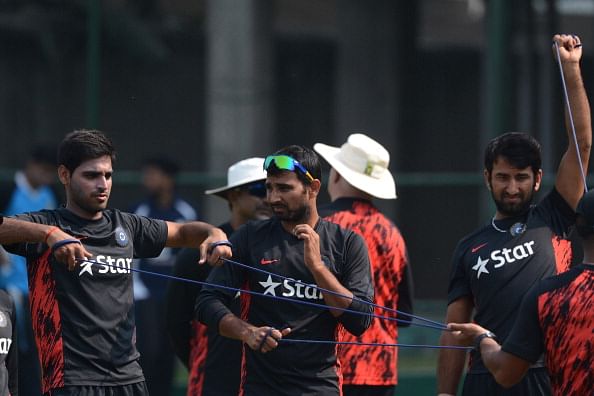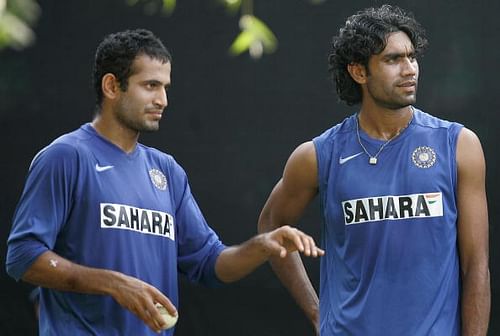
Why India needs Impact fast bowlers

Bhuvneshwar Kumar and Mohammed Shami are India’s current crop of upcoming pace bowlers, but can they really become impact bowlers?
History is witness to the fact that the most dominant teams in cricket have always had fearsome and accurate bowlers. This flows from the most basic tenet of Test Cricket that taking 20 wickets will win you the match.
All of us will agree that the West Indies team of the 1980s and the Australians during the first decade of this century were truly invincible. West Indies did not lose a Test series from 1980 to 1995. That is 15 long years! Such was there dominance at one point of time.
Similarly, the Australians twice went on to win 16 consecutive Tests (incidentally, on both the occasions, it was India who denied them the 17th win). Moreover, during the 2000s, they had won an incredible 79 of the 115 Tests played and had lost just 18.
We have also slowly seen South Africa slowly becoming the No. 1 Test team in the world (they were in any case more than formidable always). Since 2006, they have just lost a couple of Test series to Australia. In terms of numbers, it is 41 wins out of 78 Tests.
All these team had one common factor when they were at their peak. They had really splendid bowling attacks. The West Indies side had bowlers who not only were absolutely accurate in their line and length, they literally sent shivers down the opposition. The quartet of Malcolm Marshall, Michael Holding, Andy Roberts and Colin Croft; and then the duo of Courtney Walsh and Curtly Ambrose were instrumental in the envious success that the West Indies achieved during the 80s and the early 90s.
Incidentally, Pakistan was a team that were able play out three drawn series with them during this period. This is not suprising as they also had stellar bowlers like Imran Khan, Waqar Younis and Wasim Akram within their ranks. The Australians had the likes of Glenn McGrath and Shane Warne and were more than ably supported by Brett Lee and Jason Gillespie. South Africa, with the three-pronged attack consisting of Dale Steyn, Vernon Philander and Morne Morkel, have more than a potent attack capable of dismantling any opposition.
When it comes to India, the game has always been batsmen oriented. However, it is a moot point to note that during the 1970s, when India enjoyed some rare success in India and overseas, it had the spin quartet of Erapalli Prasanna, B.S. Chandrasekhar, S Venkataraghavan and Bishen Singh Bedi.
The first decade of this century, which can easily be called the ‘Golden Era’ of Test cricket, the spin duo of Harbhajan Singh and Anil Kumble had spun their way to 1100 wickets combined. There was the indefatigable Zaheer Khan who was the lynchpin of pace bowling. There were almost a dozen more fast bowlers who came and went after short stints at the international level. Most of them succumbed to injuries and were not able to maintain their form.
Nevertheless, India has always been lacking an impact fast bowler like Dale Steyn or a Mitchell Johnson. It’s not as if the country is lacking fast bowlers. There have been so many bowlers like Lakshmipathy Balaji, Munaf Patel, V.R.V Singh who were express bowlers at the beginning of their careers. Then they succumbed to injuries and were never the same again. Ashish Nehra, R. P. Singh, Irfan Pathan and Praveen Kumar, who were capable of generating such prodigious swing, have gone into the wilderness due to injuries. Sreesanth was so deadly on his day. But then he just went wayward, and I am not referring to his bowling here!

Far too many talented Indian bowlers have had starts and then gone off the radar
Presently, India has a young and talented crop of fast bowlers and medium-fast bowlers. Umesh Yadav and Varun Aaron can make the speed guns talk. Mohammed Shami and Bhuvneshwar Kumar can swing the ball. Ishant Sharma, even after such a long sting with the national team, is yet to perform regularly. Flashes of brilliance are not enough. But he has age on his side and there’s still a long way to go for him.
What’s more, the IPL has thrown up more promising prospects like Mohit Sharma, Ishwar Pandey, Rahul Shukla and Siddharth Kaul, amongst others. Having a pool of talented youngsters is only the first step. These bowlers need to nurtured and mentored properly by the management and need to be guided towards the direction. India has lost many a talent due to injuries and mismanagement. They need to be given the right sort of training. The management and the coaching staff need to improve upon the individual strengths of these bowlers and work towards their weaknesses.
Furthermore, all of them need to get a good amount of exposure to the responsive pitches in England, Australia and South Africa. They need to be a part of ‘A’ team tours and should also be included in the senior team’s squad for overseas tours. The players may not develop as lethal and accurate as Dale Steyn or McGrath (or maybe they will!), but they will surely not be a walkover for the opposition.
Winning Test matches overseas is considered to be the pinnacle, and rightly so, considering the relative dearth of overseas wins in the history of Test cricket in India. This will not be possible if India doesn’t produce steady and reliable fast bowlers who can make the opposition batsman dance to their tunes.